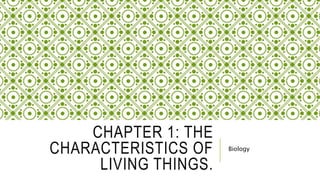Ch.1.the characteristics of living things (biology)
•Download as PPTX, PDF•
3 likes•3,364 views
7 life processes, sign of life
Report
Share
Report
Share

More Related Content
What's hot
What's hot (20)
Unit 3, Lesson 3.2 - Levels of Biological Organization

Unit 3, Lesson 3.2 - Levels of Biological Organization
Viewers also liked
Viewers also liked (20)
Similar to Ch.1.the characteristics of living things (biology)
Similar to Ch.1.the characteristics of living things (biology) (20)
Unit-2,(Lecture-3rd)Characterstics to living organism.pptx

Unit-2,(Lecture-3rd)Characterstics to living organism.pptx
Biology - What you absolutely must know to pass the living environment regents

Biology - What you absolutely must know to pass the living environment regents
Ch.4.less.2.how does energy flow between organisms in an ecosystem

Ch.4.less.2.how does energy flow between organisms in an ecosystem
More from Reem Bakr
More from Reem Bakr (20)
Classroom rules and intro. to chemistry igcse (ext.)

Classroom rules and intro. to chemistry igcse (ext.)
Classroom rules and intro. to chemistry igcse (core)

Classroom rules and intro. to chemistry igcse (core)
Recently uploaded
Organic Name Reactions for the students and aspirants of Chemistry12th.pptx

Organic Name Reactions for the students and aspirants of Chemistry12th.pptxVS Mahajan Coaching Centre
APM Welcome, APM North West Network Conference, Synergies Across Sectors

APM Welcome, APM North West Network Conference, Synergies Across SectorsAssociation for Project Management
Recently uploaded (20)
Science 7 - LAND and SEA BREEZE and its Characteristics

Science 7 - LAND and SEA BREEZE and its Characteristics
TataKelola dan KamSiber Kecerdasan Buatan v022.pdf

TataKelola dan KamSiber Kecerdasan Buatan v022.pdf
Organic Name Reactions for the students and aspirants of Chemistry12th.pptx

Organic Name Reactions for the students and aspirants of Chemistry12th.pptx
Hybridoma Technology ( Production , Purification , and Application ) 

Hybridoma Technology ( Production , Purification , and Application )
Measures of Central Tendency: Mean, Median and Mode

Measures of Central Tendency: Mean, Median and Mode
APM Welcome, APM North West Network Conference, Synergies Across Sectors

APM Welcome, APM North West Network Conference, Synergies Across Sectors
Presiding Officer Training module 2024 lok sabha elections

Presiding Officer Training module 2024 lok sabha elections
Contemporary philippine arts from the regions_PPT_Module_12 [Autosaved] (1).pptx![Contemporary philippine arts from the regions_PPT_Module_12 [Autosaved] (1).pptx](data:image/gif;base64,R0lGODlhAQABAIAAAAAAAP///yH5BAEAAAAALAAAAAABAAEAAAIBRAA7)
![Contemporary philippine arts from the regions_PPT_Module_12 [Autosaved] (1).pptx](data:image/gif;base64,R0lGODlhAQABAIAAAAAAAP///yH5BAEAAAAALAAAAAABAAEAAAIBRAA7)
Contemporary philippine arts from the regions_PPT_Module_12 [Autosaved] (1).pptx
Presentation by Andreas Schleicher Tackling the School Absenteeism Crisis 30 ...

Presentation by Andreas Schleicher Tackling the School Absenteeism Crisis 30 ...
Ch.1.the characteristics of living things (biology)
- 1. CHAPTER 1: THE CHARACTERISTICS OF LIVING THINGS. Biology
- 2. LIVING AND NEVER LIVED Living things have seven features that differentiate them from non-living things.
- 3. SIGNS OF LIFE The 7 life processes are: 1) Feeding (nutrition) 2) Respiration 3) Movement 4) Growth 5) Excretion 6) Reproduction 7) Irritability (sensitivity)
- 4. ANIMAL LIFE - All animals show the 7 signs of life in different ways Example (1): Crabs and lobsters have a skeleton outside their bodies, so they grow by shredding
- 5. Example (2): Axolotls have gills outside their bodies to help them get the oxygen they need from the water.
- 6. PLANT LIFE - Plants show the 7 signs of life in different ways than animals. - Plants make their food using the process of photosynthesis. - Some plants reproduce by making seeds or spores and some make copies of themselves called plantlets.
- 7. LOOKING AT SIGNS OF LIFE MRS. NERG / MRS. GREN
- 8. 1) EATING AND FEEDING - Plants make their own food. But, - Animals must get it from other living things.
- 9. Example: In rainforests ticks, lice, leeches and mosquitoes feed on blood. N.B. Leeches are sometimes used to draw out blood as part of a medical operation. Leech mouth
- 10. 2) RESPIRATION RESPIRATION is NOT, the same as BREATHING.
- 11. - Respiration is the process by which energy is released from food. - Respiration takes place in animals and plants (during nighttime).
- 12. 3) MOVEMENT - Muscles help animals move to find food, shelter and avoid enemies. - Our heart is made of muscles to pump blood around the body. - The wall of the stomach is made of muscles to churn the food. - There are muscles between the ribs that help them up and down.
- 13. 4) IRRITABILITY (SENSITIVITY) - Animals detect or sense changes in their surroundings by their sense organs. Example (1): Antennae Centipedes use their antennae to touch the ground and then send the information to the brain to help them decide if it is
- 14. Example (2): - The grass snake sticks out its tongue to collect chemicals in the air. - Its draws its tongue back into its mouth and pushes the tip into a pit in its nose where the chemicals are detected.
- 15. 5) GROWTH AND, 6) REPRODUCTION - Reproduction is the process that keeps a plant or animal species in existence. Example (1):
- 16. Example (2): Young animals need food to grow healthily.
- 17. 7) EXCRETION - When food and oxygen are used up in the body, waste products are made. - The body must get rid of the waste products because they are poisonous. - Wastes are released in urine, sweat and air we breathe out.
